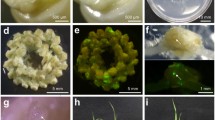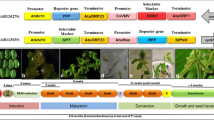Abstract
Efforts to increase the frequency of recovered homozygous transgenic B. napus plants from direct DNA transformation treatments led to the development of a method of combined microprojectile bombardment and desiccation/DNA imbibition. The combined method was compared to individual treatments in two experiments utilizing microspore-derived embryo hyocotyls as targets for the β-glucuronidase (GUS) and NPT II genes. Both the transient gene expression of β-GUS and the stable transformation by NPT II demonstrated that the combined use of microprojectile bombardment and desiccation/DNA imbibition yielded more transgenic plants (at least three-times more) than either individual transformation protocol. In a histochemical analysis for β-GUS activity, an average of 37% of the hypocotyls receiving the combined treatment displayed a positive response, whereas only 8% of the hypocotyls showed a positive response following microprojectile bombardment alone. The hypocotyls obtained by the joint treatment also showed more multisite expression of the β-GUS gene per hypocotyl than those treated only with microprojectile bombardment. Southern analysis of NPT II gene integration into subsequently-derived secondary embryos indicated that the transformation efficiency of the combined treatment was 2% in comparison to 0.6% for that of the singular microprojectile bombardment. The number of inserts integrating per transformation event appears to be independent of the transformation methods. Neither of the marker genes was expressed in hypocotyls treated only with desiccation/DNA imbibition. Utilization of hypocotyl regeneration from microspore-derived embryos via a secondary embryogenesis system provided a reliable method for producing transgenic plants. The combined use of microprojectile bombardment and desiccation/DNA imbibition proved to be an efficient approach to obtain homozygous transgenic canola plants.
Similar content being viewed by others
References
Bidney D, Scelonge C, Martich J, Burrus M, Sims L, Huffman (1992) Microprojectile bombardment of plant tissues increases transformation frequency by Agrobacterium tumefaciens. Plant Mol Biol 18:301–313
Chen JL (1991) Evaluation of microspore culture in germ plasm preservation, lipid biosynthesis and DNA uptake studies in rapeseed (Brassica napus L.). PhD thesis, University of Guelph
Coventry J, Kott L (1988) Manual for microspore culture technique for Brassica napus. Crop Science Department, University of Guelph, Guelph. Ontario Canada
Edwards K, Johnston C, Thompson C (1991) A simple and rapid method for the preparation of plant genomic DNA for PCR analysis. Nucleic Acids Res 19:1349
Gamborg OL, Miller RA, Ojima K (1968) Nutrient requirements of suspension cultures of soybean root callus. Exp Cell Res 50:151–158
Gasser CS, Fraley RT (1989) Genetically engineered plants for crop improvement. Science 244:1293–1298
Gould J, Devey M, Ulian EC, Hasegawa O, Peterson G, Smith RH (1991) Transformation of Zea mays L. using Agrobacterium tumefaciens and the shoot apex. Plant Physiol 95:426–434
Hess D (1969) Versuche zur Transformation an hoheren Pflanzen: Induktion und Konstante Weitergabe der Anthocyansynthese bei Petunia hybrida. Z Pflanzenphysiol 60:348–358
Hussey G, Johnson RD, Warren S (1989) Transformation of meristematic cells in the shoot apex of cultured pea shoots by Agrobacterium tumefaciens and A. rhizogenes. Protoplasma 148:101–105
Jefferson RA (1987) Assaying chimeric genes in plants: the GUS gene fusion system. Plant Mol Biol Rep 5:387–405
Kaeppler HF, Somers DA, Rines HW, Cockburn AF (1992) Silicone carbide fiber-mediated stable transformation of plant cells. Theor Appl Genet 84:560–566
Klein TM, Wolf ED, Wu R, Sanford JC (1987) High velocity microprojectile for delivering nucleic acids into living cells. Nature 327:70–73
Klein TM, Harper EC, Svab Z, Sanford JC, Fromm ME, Maliga P (1988) Stable genetic transformation of intact Nicotiana cells by particle bombardment projectiles. Proc Natl Acad Sci USA 85:8502–8508
Kleinhofs A, Behki R (1977) Prospects for plant genome modification by nonconventional methods. Annu Rev Genet 11:79–101
Kleinhofs A, Eden FC, Chilton MD, Bendich AJ (1975) On the question of the integration of exogenous bacterial DNA into plant DNA. Proc Natl Acad Sci USA 72:2748–2752
Kosugi S, Ohashi Y, Nakajima K, Arai Y (1990) An improved assay for β-glucuronidase in transformed cells: methanol almost completely suppresses a putative endogenous β-glucuronidase activity. Plant Sci 70:133–140
Ledoux L, Huart R (1969) Fate of exogenous bacterial deoxyribonucleic acids in barley seedlings. J Mol Biol 43:243–262
Lichter R (1982) Induction of haploid plants from isolated pollens of Brassica napus. Z Pflanzenphysiol 105:427–434
MaCabe DE (1988) Stable transformation of soybean by particle acceleration. Bio/Technology 6:923–928
Negrutiu I, Shillito RD, Potrykus I, Biasini G, Sala F (1987) Hybrid genes in the analysis of transformation conditions. I. Setting up a simple method for direct gene transfer to protoplast. Plant Mol Biol 8:363–373
Potrykus I (1990) Gene transfer to cereals: an assessment. Bio/Technology 8:535–542
Potrykus I (1991) Gene transfer to plants: assessment of published approaches and results. Annu Rev Plant Physiol Plant Mol Biol 42:205–225
Rogers SO, Bendich AJ (1988) Extraction of DNA from plant tissues. Plant Molecular Biology Manual A6:1–10
Sambrook J, Fritsch EF, Maniatis T (1989) Molecular cloning: a laboratory manual, 2nd edn. Cold Spring Harbour Laboratory, Cold Spring Harbor, New York
Schrammeijer B, Sijmons PC, vanden Elzan JM, Hoekema (1990) Meristem transformation of sunflower via Agrobacterium. Plant Cell Rep 9:55–60
Senaratna T, McKersie BD, Kasha JK, Procunier JD (1991) Direct DNA uptake during the imbibition of dry cells. Plant Sci 79: 223–228
Shillito I, Saul MW, Paszkowski J, Muller M, Potrykus I (1985) High frequency direct gene transfer to plants. Bio/Technology 3: 1099–1103
Soyfer VN (1980) Hereditary variability of plants under the action of exogenous DNA. Theor Appl Genet 58:225–235
Topfer R, Gronenborn B, Schell J, Steinbiss HH (1989) Uptake and transient expression of chimeric genes in seed-derived embryos. Plant Cell 1:133–139
Ulian EC, Smith RH, Gould JH, McKnight TD (1988) Transformation of plants via the shoot apex. In-vitro Cell Dev Biol 24: 951–954
Weber G, Monajembashi S, Greeulich KO, Wolfrum J (1988) Microperforation of plant tissue with a UV laser microbeam and injection of DNA into cells. Naturwissenschaften 75: 35–36
Author information
Authors and Affiliations
Additional information
Communicated by G. Wenzel
Rights and permissions
About this article
Cite this article
Chen, J.L., Beversdorf, W.D. A combined use of microprojectile bombardment and DNA imbibition enhances transformation frequency of canola (Brassica napus L.). Theoret. Appl. Genetics 88, 187–192 (1994). https://doi.org/10.1007/BF00225896
Received:
Accepted:
Issue Date:
DOI: https://doi.org/10.1007/BF00225896




